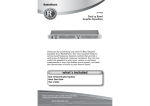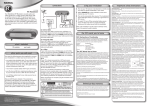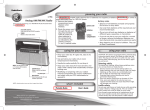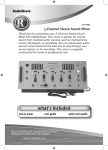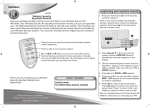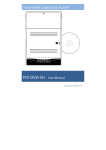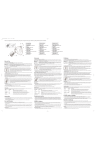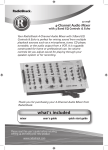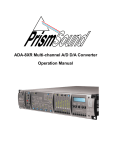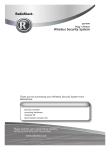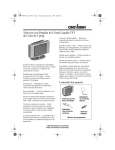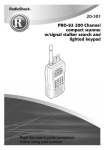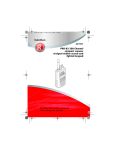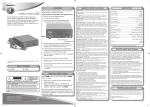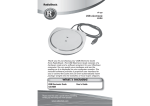Download Radio Shack 32-2055 User`s guide
Transcript
32-2055 250-watt stereo power amplifier Thank you for purchasing your 250-Watt Power Amplifier from RadioShack. This PA gives you the versatility and power you need in a professional sound system. Its wide frequency response easily handles amplification of voice and music. Use it anywhere you need to deliver special announcements with excellent sound. It is perfect for meeting halls, auditoriums, sporting events, schools, or in the office for paging systems. With a bridged speaker connection, the amplifier can produce up to 350 watts of clean, powerful sound with minimum distortion. 250W Power Amplifer User’s Guide Please read this user’s guide before installing, setting up and using your new product www.radioshack.com Quick Start Guide The Basics The Basics contents features 4 front view ................................................................. 4 rear view .................................................................. 6 important safety instructions (UL 6500) setting up your new amplifier using speaker A/B replacing the fuse product specifications FAQs 24 24 26 27 8 12 find a home for your new amplifier ........................ 12 preset the controls .................................................. 12 preset the audio input source ................................. 12 presetting the amplifier ........................................... 13 connecting your amplifier 13 connecting input sources ........................................ 13 connecting microphones ........................................ 13 connecting a turntable ............................................ 14 connecting an auxiliary sound source.................... 15 connecting the MIX BUS jack ................................. 15 connecting an equalizer .......................................... 15 connecting speakers ............................................... 16 determining total speaker impedance .................... 16 preparing the speaker wires ................................... 17 connecting two speakers in series ......................... 17 connecting two speakers in parallel ....................... 18 unbridged connection ............................................. 19 bridged connection ................................................. 20 connecting power.................................................... 21 operating your amplifier monitoring sound sources CAUTION RISK OF ELECTRIC SHOCK DO NOT OPEN CAUTION: TO REDUCE THE RISK OF ELECTRIC SHOCK, DO NOT REMOVE THE COVER OR BACK. NO USER-SERICEABLE PARTS INSIDE. REFER SERVICING TO QUALIFIED PERSONNEL. 22 23 The lightning symbol is intended to alert you to the presence of uninsulated, dangerous voltage within this product’s enclosure that might be of sufficient magnitude to constitute a risk of electric shock. Do not open the product’s case. listening safely ......................................................... 23 using the feedback filter using the level meters and clipping indicator 2 ! WARNING: To reduce the risk of fire or shock hazard, do not expose this product to rain or moisture 23 24 ! The exclamation symbol is intended to inform you that important operating and maintenace instructions are included in the literature accompanhing this product. 3 The Basics The Basics features CLIPPING Indicator Lights up to remind you to reduce volume when the amplifier output is too high. front view Illuminated Power Switch Lights up when you turn on the switch. Output Power Level LED Indicators Indicate the total stereo output power level MIC 1, MIC 2, and MIC 3 Adjust volume for the connected microphones. A/B Speaker Switch Select the speakers you want to use with the amplifier in Channel A, Channel B, or both (for use with 8 ohm speakers only). 4 PHONES Jack Connect headphones here. PROTECTION Indicator Lights up when the amplifier overheats or if a shorted load occurs on the amplifier output. The amplifier resets itself when the problem is corrected. CD/AUX Adjust volume of CD or auxiliary sound source. FEEDBACK FILTER Turn to control audio feedback. MIC 4/PHONO Adjust volume of connected microphone (MIC 4) or turntable. Volume Control: Left/Right speakers Turn to regulate volume of left and right speakers. 5 The Basics The Basics rear view Cooling Fan Automatically activated whenever the amplifier is turned on. This forced air cooling system rapidly exhausts interior heat to reduce operating temperature. XLR Balanced Microphone Inputs Connect up to four highimpedance microphones to your amplifier. Audio Input Jacks Connect input sources (CD or DVD player, TV, etc.) here, via an unbalanced audio cable. Match the colors on your cable connections with the colors on the jacks. ¼” Stereo Input Jacks Connect stereo input sources (CD or DVD player, TV, etc.) here, via a ¼ (balanced) audio cable. Fuse Ground Wire Connection ¼” Unbalanced Microphone Inputs Connect up to four microphones to your amplifier, via a ¼” unbalanced cable, for left and right mono sound. Phono Input Jacks Connect your turntable here. MIC 4/PHONO Switch Select MIC 4 or PHONO input. MIX BUS Jack Connect an extra amplifier if you have multiple audio sources. 6 CD/AUX Jack Connect any high-level sound source for music or special effects. STEREO/MONO Selector Select bridged mono input mode in combination with a mono signal source plugged into the left channel. EQ/BYPASS Selector Select EQ if you are using an equalizer or BYPASS if you are using another external processor. Speaker Terminals Connect two sets of speakers (Left and Right, for A and B). EQ IN/OUT Jacks Connect an equalizer or other external processor. 7 The Basics The Basics important safety instructions (UL 6500) 1. Read all safety and operating instructions before the appliance is operated. 2. Keep all safety and operating instructions for future reference. 3. Follow all warnings on the appliance and in the operating instructions. 4. Unplug this appliance from the wall outlet before cleaning. Use only a damp cloth for cleaning. Do not use liquid or aerosol cleaners. 5. Do not use this appliance near water (for example, near a bathtub, washbowl, kitchen sink, or laundry tub; in a wet basement; or near a swimming pool). 6. Do not place this appliance on an unstable cart, stand, tripod, bracket, or table. The appliance may fall, causing serious injury to a child or adult, and serious damage to the appliance. Use only with a cart, stand, tripod, bracket, or table recommended by the manufacturer or sold with the appliance. Follow the manufacturer's instructions for mounting, and use a recommended mounting accessory. 7. Slots and openings in the cabinet provide ventilation, ensure reliable operation, and protect from overheating. Do not block or cover these openings, and do not place the appliance on a bed, sofa, rug, or other similar surface. Do not place the appliance in a built-in installation such as a bookcase or rack unless it provides proper ventilation as specified by the manufacturer. 8. Keep appliance away from heat sources such as radiators, heat registers, stoves, or other appliances (including amplifiers) that produce heat. 8 9. Operate this appliance using only the power source indicated on its marking label. If you are not sure of your home's power type, consult your appliance dealer or local power company. 10. This appliance is equipped with a polarized power cord plug (a plug having one blade wider than the other). This plug will fit in the power outlet only one way. This is a safety feature. If you cannot insert the plug fully into the outlet, try reversing the plug. If the plug still doesn’t fit, contact your electrician to replace your obsolete outlet. Do not defeat the safety purpose of the polarized plug. 11. Route power-supply cords so they are not likely to be walked on or pinched by items placed on or against them, paying particular attention to cords at plugs, convenience receptacles, and the point where they exit from the appliance. 12. Clean only as recommended by the manufacturer. 13. An outside antenna system should not be located in the vicinity of overhead power lines or other electric light or power circuits, or where it can fall into such power lines or circuits. When installing an outside antenna system, extreme care should be taken to keep from touching such power lines or circuits as contact with them might be fatal. 14. Unplug the power cord from the outlet when you know that you will not be using the appliance for a long period of time. 15. Do not overload wall outlets, extension cords, or integral convenience receptacles, as this can result in a risk of fire or electric shock. 16. Never push objects of any kind into this appliance through openings, as they may touch dangerous voltage points or short out parts that could result in a fire or electric shock. Never spill liquid of any kind on the appliance. 9 The Basics The Basics 17. Move appliance and cart combinations with care. Quick stops, excessive force, and uneven surfaces may cause the appliance and cart combination to overturn. 18. Unplug this appliance from the wall outlet and refer servicing to qualified service personnel under the following conditions: • When the power-supply cord or plug is damaged. • If liquid has been spilled or objects have fallen into the appliance. • If the appliance has been exposed to rain or water. • If the appliance does not operate normally by following the operating instructions. Adjust only those controls that are covered by the operating instructions, as an improper adjustment of other controls may result in damage and will often require extensive work by a qualified technician to restore the appliance to normal operation. • If the appliance has been dropped or damaged in any way. • When the appliance exhibits a distinct change in performance. 19. Do not attempt to service this appliance yourself, as opening or removing covers may expose you to dangerous voltage or other hazards. Refer all servicing to qualified service personnel. 11. When replacement parts are required, be sure the service technician has used replacement parts specified by the manufacturer or have the same characteristics as the original part. Unauthorized substitutions may result in fire, electric shock, or other hazards. 12. Upon completion of any service or repairs to this appliance, ask the service technician to perform safety checks to determine that the appliance is in proper operating condition. 13. For added protection for this product during a 10 lightning storm, unplug it from the wall outlet. This will prevent damage to the product due to lightning and power line surges. 14. Only use attachments recommended by the product manufacturer. 15. The product should be mounted to a wall or ceiling only as recommended by the manufacturer. 11 The Basics The Basics setting up your new amplifier presetting the amplifier To prevent possible hearing loss, set the controls on the amplifier to the following: Control Setting find a home for your new amplifier POWER Out Before you use your amplifier, be sure to place it on a surface with adequate ventilation. Do not put it on thick carpeting, which can restrict air flow, or near a heat source such as a heat vent or radiator, which can cause it to overheat. MIC 1, MIC 2, MIC 3, MIC 4/PHONO, CD/AUX Volume Control Min LEFT and RIGHT Volume Control Min preset the controls Before you begin connecting or using your amplifier, preset the controls on the audio input source and amplifier to avoid overdriving a channel or producing loud sounds. After you turn on the amplifier or change the program source, set the controls to a comfortable listening level. connecting your amplifier preset the audio input source connecting input sources Set the controls on the audio input sources to the following levels: You can connect optional components, such as microphones, tuner, turntable, audio mixer, preamplifier, or CD player to your amplifier to expand your system. To prevent hum and other noise, use low-capacitance shielded cable. Your local RadioShack store carries a wide selection of audio components and connecting cables. • This amplifier is equipped with both stereo phono NOTES input and ¼-inch (6.35mm) jacks. The ¼-inch input jacks on the top are stereo while the others are left and right mono. • Before you make any connections, be sure POWER on the front of amplifier is out and AC power cord is not plugged in. Audio Device Control Setting Turntable Power Off Tape Deck Power Off CD Player Power Off Amplifier Power Off Receiver Tone Flat connecting microphones You can connect up to four high- or low- impedance microphones to the microphone inputs on the back of the amplifier. Each input (labeled MIC1, MIC2, MIC3, and MIC4) has a balanced and unbalanced jack. You need a microphone with a ¼-inch (6.35mm) plug to connect to an unbalanced jack or a microphone cord with a 3-pin XLR plug to connect to a balanced jack. 12 13 The Basics The Basics connecting an auxiliary sound source Balanced Microphone Jacks NOTES Unbalanced Microphone Jacks • If your microphone cord is longer than 20 feet (6 meters), we recommend that you connect it to a balanced jack to reduce signal hum. You can connect any high-level sound source, such as a CD player, tape deck, or tuner, to the CD/AUX jack on the back of the amplifier. CD/AUX Jack connecting the MIX BUS jack • If you connect a microphone to both balanced and unbalanced jacks for MIC1, MIC2, MIC3, or MIC4, the microphone you connect to the unbalanced jack has priority. You can connect another MPA-250 to double the size of your PA system. You can then use up to eight microphones (or six microphones and two turntables) and two auxiliary sound sources. • If you connect a microphone to either MIC4 jack, set MIC4/PHONO on the back of the amplifier to MIC4. Use a shield cable with phono plugs at each end. Connect the cable between the MIX BUS jacks on the back of the two amplifiers. For best results, do not use cable longer than 1.8 connecting a turntable You can connect a low-level audio input source (such as a magnetic cartridge turntable) to the L PHONO and R PHONO jacks on the back of the amplifier. If you connect a low-level audio input source to the PHONO jacks, set MIC4/PHONO on the back of the amplifier to PHONO. To avoid a low-level hum, connect your turntable's ground wire (usually black or green) to the GND terminal on the amplifier. PHONO Input Jacks MIX BUS Jack meters (6 feet). connecting an equalizer You can connect an equalizer or other external signal EQ IN/OUT Jacks GND Terminal MIC 4/ PHONO Switch processor to the EQ IN and EQ OUT jacks on the back of the amplifier. NOTE You can also connect a tape deck to the EQ OUT jack for recording. The EQ IN/OUT jacks handle the signal from an outside equalizer. They do not handle the signal from this equalizer’s stereo INPUT jacks. 14 15 The Basics The Basics connecting speakers You can connect one or more 4-, 8-, or 16-Ohm speakers to the amplifier. To ensure equal volume from each speaker, all connected speakers should have the same impedance rating. Proper phasing is important when you use more than one speaker in the same room or area. Out-of-phase speakers can lose up to one-half of their potential volume, and can have a significantly decreased bass effect . Most speaker terminals are color-coded or have a mark that indicates the terminal’s polarity. Usually, terminals with positive polarity are red or have a plus (+) symbol, and terminals with negative polarity are black or have a minus (-) symbol. Phasing is correct when you connect + to + and - to -. exceed the amplifier’s maximum impedance (16 ohms) or fall below the minimum impedance (4 ohms). You can achieve a proper total impedance by combining series and parallel connections. NOTE preparing the speaker wires Use the shortest length of wire possible to connect the speakers. After placing the speakers, use this table to determine the wire length and choose the appropriate gauge. You can also bridge the amplifier's channels. The amplifier has two channels: A and B. If you connect two pairs of speakers, follow these guidelines: • • Speakers connected to the same channel (A or B) are part of a pair and must be of the same impedance. Speakers connected to different channels (A or B) are not part of a pair and can be different impedance. STEREO/MONO Switch Speaker Terminals A total speaker impedance higher than 16 ohms or lower than 4 ohms can damage your amplifier or speakers. When determining the total speaker impedance, first determine whether you are connecting the speakers in series, parallel, or a series/parallel combination. Wire Length Wire Gauge 7.6m (25 ‘) or less 18 gauge Over 7.6m (25‘) 16 gauge To prepare the speaker wire, remove about 1/2 inch (12.5mm) of insulation from the end of the speaker wire you are connecting to the amplifier. Then twist the exposed wire to secure all of the wire strands. connecting two speakers in series Speakers are connected in series when the first speaker’s positive terminal is connected to the next speaker’s negative terminal. determining total speaker impedance Before you connect speakers to the amplifier, you must determine the total speaker impedance. To determine total speaker impedance, you must first decide if you are going to connect the speakers in series, parallel, or a series/parallel combination. NOTE Determine the total speaker impedance of speakers you want to connect in series by adding up the individual impedances of all the connected speakers. For example: If connecting two 4-ohm speakers in series, your total speaker impedance is 8 ohms. If you are connecting more than two speakers in series only or parallel only, be sure the total impedance does not 16 17 The Basics The Basics unbridged connection Use this connection if you are connecting more than one speaker on the same channel or if you do not have highpower speakers. connecting two speakers in parallel Speakers are connected in parallel when the speakers’ negative terminals are connected together and all their positive terminals are connected together. NOTE Determine the total speaker impedance of speakers you want to connect in parallel by dividing the impedance of one speaker by the number of speakers. 1. Connect the speaker wires to the corresponding left and right positive (+) and negative (–) speaker terminals. 2. Connect the other end of the left and right speaker's positive (+) and negative (–) wires to the amplifier's corresponding SPEAKER LEFT and SPEAKER RIGHT terminals for each channel. To connect speaker wires to the amplifier, turn the knob on the terminal counterclockwise until it stops, insert the bare wire inside the space between the knob and the amplifier, then turn the knob clockwise until it stops to secure it. 3. Make sure the STEREO/MONO switch is set to STEREO. For example: If connecting two 8-ohm speakers in parallel, divide 8 (one speaker’s impedance) by 2 (number of speakers). Your total speaker impedance is 4. RIGHT Speaker LEFT Speaker Unbridged 18 19 The Basics The Basics bridged connection connecting power Use this connection if you have high power speakers that can handle a power output of 350 Watts. To connect the amplifier to power, plug the attached power cord into a standard AC outlet. Your amplifier's fuse (located on the amplifier's back panel) protects the amplifier from voltage surges. If the amplifier does not work when you press POWER, check the fuse. If it is blown, see "Replacing the Fuse.” NOTE For a bridged connection, do not connect any speaker wire to the black SPEAKER terminals. 1. Connect the speaker wires to the speaker's positive (+) and negative (–) terminals. 2. Connect the other end of the speaker's positive (+) and negative (–) wires to the amplifier's red SPEAKER LEFT and SPEAKER RIGHT terminals. NOTE SPEAKER RIGHT (+) on the amplifier is used as a negative (–) terminal for a bridged connection. 3. Make sure STEREO/MONO is set to MONO. NOTE In the bridged mono mode, only the LEFT volume control adjusts the output level. RIGHT Speaker LEFT Speaker Bridged 20 21 The Basics Beyond the Basics operating your amplifier 1. Start the input sound source. 2. Make sure LEFT and RIGHT volume control on the front of the amplifier are set to MIN. Left Volume Control monitoring sound sources To monitor the sound sources, plug a pair of mono or stereo headphones (not supplied) with a ¼-inch (6.35mm) plug into the PHONES jack on the front of the amplifier. Headphones sometimes make it easier to check and adjust the sound source's balance. Right Volume Control 3. Press POWER in to turn on the amplifier. The blue light around the power switch and LEFT/RIGHT volume control will illuminate. PHONES Jack listening safely To protect your hearing, follow these guidelines when you use headphones. Power Switch • 4. Rotate LEFT and RIGHT volume controls to their middle positions. 5. One at a time, adjust MIC1, MIC2, MIC3, MIC4/ PHONO, and CD/AUX to the desired volume and balance. MIC4/ PHONO CD/AUX MIC1 MIC2 FEEDBACK FILTER MIC3 NOTE If you hear feedback after you adjust these controls, turn FEEDBACK FILTER clockwise until the noise disappears (see “Using the Feedback Filter,” p. 23). 6. Adjust LEFT and RIGHT volume controls to the desired volume level after you find your desired balance. 22 • • Set the volume to the lowest setting before you begin listening. After you begin listening, adjust the volume to a comfortable level. Do not listen at extremely high volume levels. Extended high-volume listening can lead to permanent hearing loss. Once you set the volume, do not increase it. Over time, your ears adapt to the volume level, so a volume level that does not cause discomfort might still damage your hearing. using the feedback filter The FEEDBACK FILTER control lets you reduce or eliminate squeal and other noise caused by feedback. After you adjust LEFT/RIGHT volume, MIC1, MIC2, MIC3, MIC4/PHONO, and CD/AUX , turn on the amplifier and any connected sound sources. If you hear any feedback, turn FEEDBACK FILTER clockwise until you reduce or eliminate the feedback. The FEEDBACK FILTER control decreases feedback frequencies by up to 12dB. If it does not eliminate NOTE the feedback, try using a frequency equalizer to further decrease the feedback frequencies. 23 Beyond the Basics Beyond the Basics using the level meters and clipping indicator The illuminating flow of the output LED indicators reflect the amplifier’s output level. The stronger the signal the more LEDs illuminate. The maximum signal through the MPA-250 should cause the CLIPPING LED to blink at peak music levels. LED Indicators CLIPPING LED using speaker A/B NOTE • Let the amplifier cool down and see if it starts again before you presume a fuse needs to be replaced. • Do not use a fuse with a rating other than that specified here. Doing so might damage your amplifier. 1. Unplug the amplifier from the AC outlet. 2. Turn the fuse holder cap on the back of the amplifier and pull out the cap to remove the fuse. 3. If the fuse is blown, replace it. Use only an identical fuse with the proper rating. The fuse must be 7 amps. 4. Insert the fuse into the fuse holder's socket, press the fuse holder back into the amplifier. Turn the fuse holder's cap clockwise to tighten it. Press in SPEAKER A or SPEAKER B on the front of the amplifier for the channel you want to listen to. Or, press in SPEAKER A and SPEAKER B to listen to all connected speakers. Speaker A NOTE Speaker B If you have connected 4-Ohm speakers to the amplifier, do not set both SPEAKER A and SPEAKER B to IN (use 8-Ohm speakers only for this mode). replacing the fuse If the amplifier does not operate, you might need to replace the fuse on the back of the amplifier with another 7-amp, 250-volt fuse, (not supplied). Fuse Holder Cap 24 25 Beyond the Basics Beyond the Basics product specifications FAQs Input Impedance................................................................. 20k Ohms Continuous Output Power Stereo at 1 kHz ....................................... 125 Watts x 2 (8 Ohms) Stereo at 1 kHz ....................................... 175 Watts x 2 (4 Ohms) Bridged at 20 Hz to 20 kHz .......................... 250 Watts (8 Ohms) Bridged at 1 kHz ........................................... 350 Watts (8 Ohms) Total Harmonic Distortion (@ 70 Watts, 8 Ohms, 1 kHz, with Band Pass Filter) MIC (Phone Jack) ............................................................... 0.20% MIC (XLR Jack) ................................................................... 0.20% CD/AUX .............................................................................. 0.15% PHONO ............................................................................... 0.20% Input Sensitivity (at 0.5% THD, 1 kHz) MIC (Phone Jack) ............................................................ 1.35 mV MIC (XLR Jack) ................................................................ 1.35 mV CD/AUX ............................................................................ 500 mV PHONO ................................................................................. 3 mV Signal to Noise Ratio (Input Shorted) with WTD MIC (Phone Jack) ................................................................ 65 dB MIC (XLR Jack) .................................................................... 65 dB CD/AUX ............................................................................... 75 dB PHONO ................................................................................ 70 dB Frequency Response (at 1 Watt, ± 3dB) MIC (Phone Jack) .................................................40 Hz ~ 20 kHz MIC (XLR Jack) .....................................................40 Hz ~ 20 kHz CD/AUX ................................................................20 Hz ~ 30 kHz PHONO (RIAA 100 Hz/10 kHz) ..........................+13dB ~ – 14dB Notch Filter Effect Range ....................................................................300 Hz ~ 3kHz Depth .................................................................................. –12dB Noise Level (Input Short) ....................................................... 0.75mV Speaker Impedance ............................................. A,B (4 ~16 Ohms) A+B (8 ~16 Ohms) Bridge(8 ~16 Ohms) Power Requirement ..................................................... 120V AC 60Hz Power Fuse ...............................................................7 Amps/250 volt Dimensions ................................................5 3/8 x 19 x 14 1/2 inches (136 x 482 x 367 mm) Weight ....................................................................... 27 lbs (12.3kgs) We do not expect you to have any problem with your amplifier. But if you do, these suggestions might help. Why isn’t my amplifier powering up, even though I have tried turning it on and off? • The fuse might be blown. Check the amplifier’s fuse and replace it if necessary. • The speakers might not be connected properly. Check all connections. Why can’t I hear anything? • The amplifier’s LEFT/RIGHT VOLUME, MIC1, MIC2, MIC3, MIC4/PHONO, or CD/AUX controls might be set to minimum. Adjust the volume control to the desired setting. • The speakers might not be connected properly. Check all connections. • A microphone or cable might be faulty. Check all microphones and cables. • The speakers might be the wrong impedance for the PA. Make sure your speaker wires are 18-gauge (for wire length up to 7.6m). For best results, use the shortest length of speaker wire possible. • The amplifier might have shut down. Turn the amplifier off and let it cool down. Make sure the amplifier is properly vented, then turn it back on. Why am I hearing feedback? • The FEEDBACK FILTER might need to be adjusted. Turn the FEEDBACK FILTER clockwise until you reduce or eliminate feedback. • Your microphones or speakers could be too close together. Reposition the microphones and speakers. NOTE: Specifications are typical; individual units might vary. Specifications are subject to change and improvement without notice. NOTE: Actual product may vary from the product images in this document. 26 27 • Keep the amplifier dry. If it gets wet, wipe it dry immediately. • Use and store the amplifier only in room temperature environments. • Handle the amplifier carefully; do not drop it. • Keep the amplifier away from dust and dirt, and wipe it with a soft cloth occasionally to keep it looking new. • If your amplifier is not performing as it should, take it to your RadioShack store for assistance. To locate your nearest RadioShack, use the store locator feature on RadioShack's website (www.radioshack.com), or call 1-800-The Shack (843-7422) and follow the menu options. Modifying or tampering with the amplifier's internal components can cause a malfunction and might invalidate its warranty. This product is warranted by RadioShack against manufacturing defects in material and workmanship under normal use for one (1) year from the date of purchase from RadioShack company-owned stores and authorized RadioShack franchisees and dealers. For complete warranty details and exclusions, check with your local RadioShack store. RadioShack Customer Relations 200 Taylor Street, 6th Floor, Fort Worth, TX 76102 04/04 Printed in China 32-2055 07A04 ©2004. RadioShack Corporation. All rights reserved. RadioShack and RadioShack.com are trademarks used by RadioShack Corporation.















